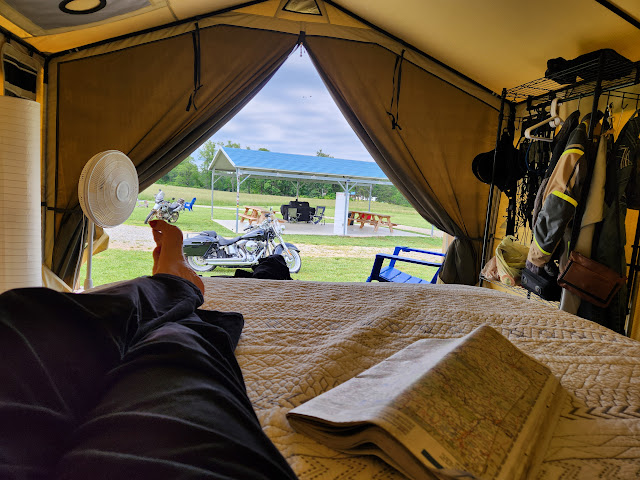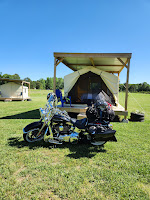When the Kid told me their wedding was scheduled for May 17th and that she would like me to ride the
 |
| Breakfast Yummies |
Road Queen down for the wedding, I warned her that the weather in May can be quite unpredictable. That we could, conceivably, even get snow in Ohio that time of year.
Fortunately, that reality eluded me prior to my departure and the Kid and Kevin were blessed with a beautiful, sunny day for their nuptials. Not so fortunately for me, the weather following my departure from their home in Illinois has not been nearly as perfect. In all honesty, rain in northern Arkansas in May is sketchy. I packed tank tops that have only seen the inside of a long sleeve shirt or jacket and shorts that have primarily been utilized for jammies. Sandals have been sentenced to bath house attire instead of camp fire gear once settled in for the evenings. The radar reports have been of questionable decency and I have come to the realization that suiting up for rain on every ride is the most prudent approach to reality this time of year here.

Yesterday was no exception. Early in the morning, I ran into Clarksville, 16 miles south of the campground, and did laundry. I was pleasantly surprised to locate a nice little place next door to the laundromat that served breakfast and featured some very yummy looking pastries. By the time my laundry was done, it was, of course, raining. I returned to camp and conferred with Dustin, one of our hosts, about the possibility of a ride. The general consensus, after looking at the radar, was that a ride to the south would probably be a safe bet to avoid another soggy ride. So I headed towards Mount Magazine, about 55 miles south. The ride started out pretty good, warming up enough for several riding apparel adjustments to meet the temperature rises. However the closer I got to route 309, the road to the state park, the temperature dropped and additional riding apparel adjustments in the other direction ensued. About a quarter of the way up, a heavy, thick fog surrounded me, with visibility down to about ten feet in
 |
| My bike is in this photo! |
spots. I passed a "watch for bears" sign and thought, great, I am doing about ten miles per hour and there are bears here??? WTF!
About halfway up the mountain, a light rain began to fall and I was now moving in and out of fog and rain. About a mile or two from the visitor center, mother nature cut lose and a downpour ensued. I mean, it was a torrential rain and it was all I could do to find the driveway entrance to the visitor center! between the rain and fog. All I could think of was, don't drop the bike or you will be a bear's next meal!
I took the first parking spot I could find at the visitor's center and sloshed my way under the canopy. I tried to pull up the radar but cell reception was not existent. So I did the tourist thing and enjoyed the dry and warm exhibits in the center to give the wrath of nature an opportunity to pass by. While I was mentally regrouping for the ride back down the mountain, a guy on a bicycle, yes, like the kind you pedal, pulls under the canopy. He had ridden his bicycle up the mountain, with the same conditions I had just encountered and said, "It wasn't supposed to rain here." I told him, yeah, I got the same weather report...

I enjoyed some of the exhibits in the center until it appeared the weather was clearing. The bicycle dude was already gone by then. I changed gloves, wiped off my helmet visor and windshield, and headed north, back down the mountain, towards Paris, Arkansas. And that's when the next wave of heavy rain hit. Fortunately, a pick up driver behind me must have understood the challenges of riding a motorcycle in those conditions and remained a fair distance back, giving me at least a small peace of mind.
Upon arriving in the city of Paris, I found the main street coming into town to resemble more of a lake that a street. Apparently their either was no drainage system or it was severally plugged, and I had literal waves cresting around my bike and water splashing up to my knees working my way through the deluge!
One final stop in Paris along the way to, once again, change gloves, wipe off my helmet visor and
windshield, do a map check and I was off to Ozone and the campground. I arrived about fifteen minutes ahead of another guest who had done a similar ride and we exchanged stories, including having seen the same bicycle rider along the way, in the rain and fog!
Our hosts were kind enough to loan me their boot drier as my leather riding boots were soaked through and my socks were like wet rags. I spent a long time in a hot shower defrosting. And I lived again, to once more, tell another fascinating story about the joys of two wheel adventures!
Peace and Love!
Bobbi



















































